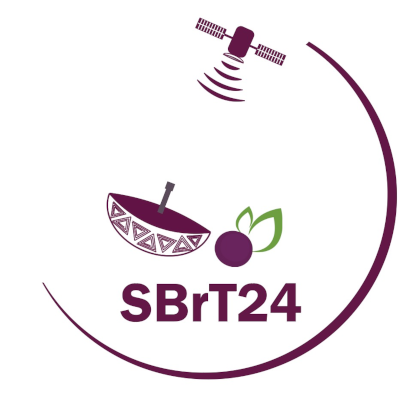
XLII Simpósio Brasileiro de Telecomunicações e Processamento de Sinais
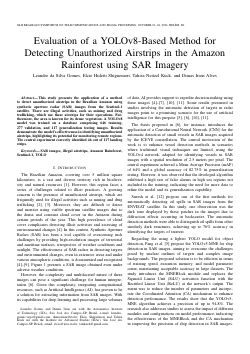
Evaluation of a YOLOv8-Based Method for Detecting Unauthorized Airstrips in the Amazon Rainforest using SAR Imagery
Leandro da Silva Gomes, Elcio Hideiti Shiguemori, Tahisa Neitzel Kuck, Dimas Irion Alves
DOI: 10.14209/sbrt.2024.1571036260
Keywords: SAR images illegal airstrips Amazon Rainforest Sentinel-1
Abstract
This study presents the application of a method to detect unauthorized airstrips in the Brazilian Amazon using synthetic aperture radar (SAR) images from the Sentinel-1 satellite. There are illegal activities, such as mining and drug trafficking, which use these airstrips for their operations. Furthermore, the area is known for its dense vegetation. A YOLOv8 model was trained on a database comprising 646 training, 277 validation, and 109 generalization testing images. Results demonstrate the model's effectiveness in identifying unauthorized airstrips, highlighting its potential for monitoring remote regions. The central experiment correctly identified 39 out of 109 landing strips.Download
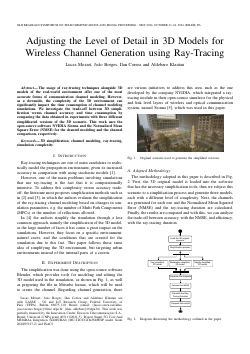
Adjusting the Level of Detail in 3D Models for Wireless Channel Generation using Ray-Tracing
Lucas Mozart Carvalho, João Paulo T Borges, Ilan S Correa, Aldebaro Klautau
DOI: 10.14209/sbrt.2024.1571036262
Keywords: 3D simplification channel modeling ray-tracing simulation complexity
Abstract
The usage of ray-tracing techniques alongside 3D models of the real-world environment offer one of the most accurate forms of communication channel modeling. However, as a downside, the complexity of the 3D environment can significantly impact the time consumption of channel modeling simulations. We investigate the trade-off between 3D simplification versus channel accuracy and time consumption by comparing the data obtained in experiments with three different simplified versions of the 3D scenario. This work uses the open-source software NVIDIA Sionna and the Normalized Mean Square Error (NMSE) for the channel modeling and the channel comparison, respectively.Download
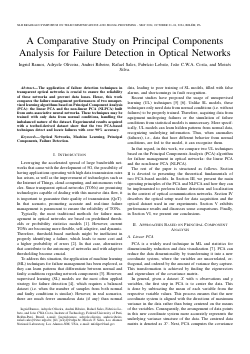
A Comparative Study on Principal Components Analysis for Failure Detection in Optical Networks
Ingrid L. F. M. Ramos, Adryele C. Oliveira, Andrei Nogueira Ribeiro, Rafael Sales, Fabrício Lobato, Joao Weyl Costa, Moisés Felipe Silva
DOI: 10.14209/sbrt.2024.1571036264
Keywords: Optical Networks Machine Learning Principal Components Failure Detection
Abstract
The application of failure detection techniques in transparent optical networks is crucial to ensure the reliability of these networks and prevent data losses. Hence, this work compares the failure management performances of two unsupervised learning algorithms based on Principal Component Analysis (PCA): the linear PCA and the non-linear PCA (NLPCA) built from auto-associative neural networks. These techniques may be trained with only data from normal conditions, handling the imbalanced nature of the dataset. Experimental results acquired with a testbed-derived dataset show that the two PCA-based techniques detect and locate failures with over 90\% accuracy.Download
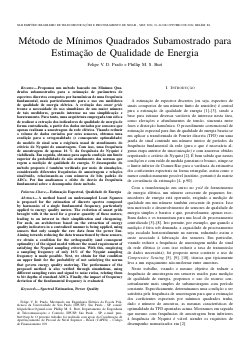
Método de Mínimos Quadrados Subamostrado para Estimação de Qualidade de Energia
Felipe V. D. Prado, Phillip M. S. Burt
DOI: 10.14209/sbrt.2024.1571036266
Keywords:
Abstract
Propomos um método baseado em Mínimos Quadrados subamostrados para a estimação de parâmetros de espectros discretos compostos por harmônicas de uma única frequência fundamental, mais particularmente para o uso em medidores de qualidade de energia elétrica. A evolução das smart grids trouxe a necessidade do uso simultâneo de um maior número de tais medidores, gerando interesse na sua simplificação e barateamento. Para tanto, uma arquitetura empregada tem sido a de realizar a extração dos indicadores de qualidade de energia de forma centralizada, a partir dos dados enviados por sensores que apenas realizam a amostragem da rede elétrica. Visando reduzir o volume de dados enviados por estes sensores, obtemos uma condição para a ortogonalidade (e consequente optimalidade) do modelo de sinal sem a exigência usual de atendimento do critério de Nyquist de amostragem. Com isso, uma frequência de amostragem de apenas 16 % da frequência de Nyquist é viabilizada. Em seguida, obtemos para aquela condição um limite superior da probabilidade de não atendimento das normas que regem a medição de qualidade de energia. O desempenho do método proposto é também verificado por meio de simulações, considerando diferentes frequências de amostragem e relações sinal/ruído, relacionando-as com números de bits padrão de ADCs. Por fim analisamos o efeito do desvio da frequência fundamental sobre o desempenho deste método.Download
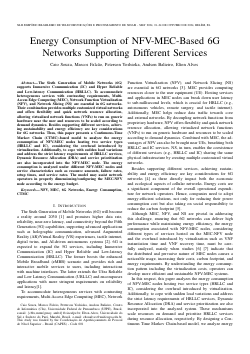
Energy Consumption of NFV-MEC-Based 6G Networks Supporting Different Services
Caio B. B. Souza, Marcos Falcão, Peterson Marcelo Santos Yoshioka, Andson M Balieiro, Elton Alves
DOI: 10.14209/sbrt.2024.1571036267
Keywords: NFV-MEC 6G Netwoks Energy Consumption CMTC
Abstract
The Sixth Generation of Mobile Networks (6G) is support Immersive Communication (IC) and Hyper Reli- able and Low-latency Communication (HRLLC). To accommodate heterogeneous services with contrasting requirements, Multi-Access Edge Computing (MEC), Network Function Virtualization (NFV), and Network Slicing (NS) are essential in 6G networks. Their combination provides multiple customized virtual networks and offers flexibility and quick network resource allocation, allowing virtualized network functions (VNFs) to run on generic hardware near the user and resources to be scaled according to demand dynamics. Besides supporting different services, achieving sustainability and energy efficiency are key considerations for 6G networks. Thus, this paper presents a Continuous-Time Markov Chain (CTMC)-based model to analyze the energy consumption of NFV-MEC nodes hosting two service types (HRLLC and IC), considering the overhead introduced by virtualization. Additionally, to cope with sudden load variations and address the strict latency requirements of HRLLC services, Dynamic Resource Allocation (DRA) and service prioritization are also incorporated into the NFV-MEC node. The energy consumption is analyzed under different NFV-MEC node and service characteristics such as resource amounts, failure rates, setup times, and service rates. The model may assist network operators in properly dimensioning/configuring the MEC-NFV node according to the energy budget.Download

Solução Descentralizada de Compartilhamento de Infraestrutura de Redes Baseada em Blockchain
Jeffson Celeiro Sousa Sr., José Reynaldo Formigoni Filho, Vinicius Duarte, Mauricio Pinto, Elder Bruno Evaristo Correa
DOI: 10.14209/sbrt.2024.1571036269
Keywords: Blockchain Telecomunicações Inovação
Abstract
Blockchain é uma tecnologia descentralizada que fornece segurança, transparência e validação de processos incomparáveis e está redefinindo o cenário operacional em vários setores. Este artigo se concentra no desenvolvimento de um método inova- dor de marketplace de telecomunicações baseado em blockchain, para oferecer um catálogo diversificado de serviços e ativos de telecomunicações, integrando-se de maneira inovadora para facilitar oferta e demanda descentralizada de serviços de Telecom. Utilizando os recursos do Hyperledger Besu, o dApp é adaptado para melhorar a segurança, escalabilidade e interoperabilidade, contribuindo assim para um ecossistema de comercialização mais integrado. Propondo um ambiente de transações financeiras seguro, transparente e eficienteDownload
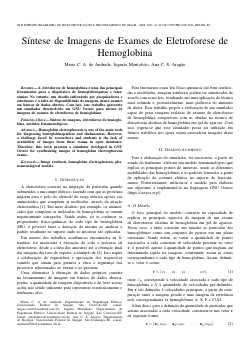
Síntese de Imagens de Exames de Eletroforese de Hemoglobina
Maria C. A. de Andrade, Jugurta Montalvao, Ana C. S. Aragão
DOI: 10.14209/sbrt.2024.1571036272
Keywords: Image synthesis hemoglobin electrophoresis phenomenological models
Abstract
Hemoglobin electrophoresis is one of the main tools for diagnosing hemoglobinopathies and thalassemias. However, a challenge faced by researchers and students is the lack of availability of images from these exams in open databases. Therefore, this work presents a simulator developed in GNU Octave for synthesizing realistic images of hemoglobin electrophoresis exams.Download

Power allocation analysis in cell-free networks
Matheus D. Carneiro, Igor Braga Palhano, Igor M. Guerreiro
DOI: 10.14209/sbrt.2024.1571036296
Keywords: Power Control Cell-free Energy Efficiency Co-channel Interference
Abstract
Power control has been used to deal with co-channel interference and energy efficiency in mobile communication systems. This work compares different power control schemes implemented in a cell-free (CF) system simulation. The approaches used are stepwise removal algorithm (SRA), fractional power control (FPC) and max power (MP). The signal-to-interference-plus-noise ratio (SINR) values indicate advantages in the use of FPC instead of SRA despite its low energy expenditure and transmitted power values shows its advantages instead of MP because of a better use of power resource.Download
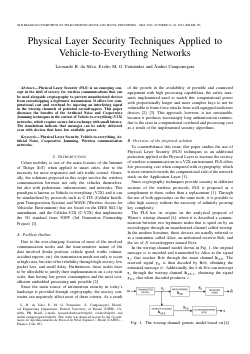
Physical Layer Security Techniques Applied to Vehicle-to-Everything Networks
Leonardo Barbosa da Silva, Evelio Fernandez, Ândrei Camponogara
DOI: 10.14209/sbrt.2024.1571036313
Keywords: Physical Layer Security Vehicle-to-everything Artificial Noise Cooperative Jamming
Abstract
Physical Layer Security (PLS) is an emerging concept in the field of secrecy for wireless communications that can be used alongside cryptography to prevent unauthorized devices from eavesdropping a legitimate transmission. It offers low computational cost and overhead by injecting an interfering signal in the wiretap channels of potential eavesdroppers. This paper discusses the benefits of the Artificial Noise and Cooperative Jamming techniques in the context of Vehicle-to-everything (V2X) networks, which require secure data exchange with small latency. The simulations indicate that messages can be safely delivered even with devices that have low available power.Download
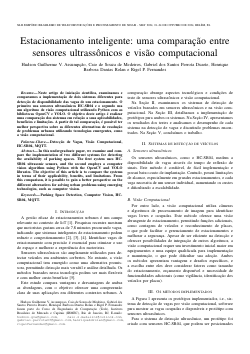
Estacionamento inteligente: uma comparação entre sensores ultrassônicos e visão computacional
Hudson Guilherme V Assumpcao, Caio de Souza de Medeiros, Gabriel dos Santos Perrota Duarte, Henrique Barbosa Dantas Rolan, Rigel P. Fernandes
DOI: 10.14209/sbrt.2024.1571036315
Keywords:
Abstract
Neste artigo, examinamos e comparamos dois sistemas diferentes para detecção de vagas de estacionamento. Um usa sensores ultrassônicos HC-SR04 e o outro usa visão computacional. Para fornecer uma visão completa das soluções de gestão de estacionamentos, examinemos as características, funcionalidade e benefícios de cada métodoDownload